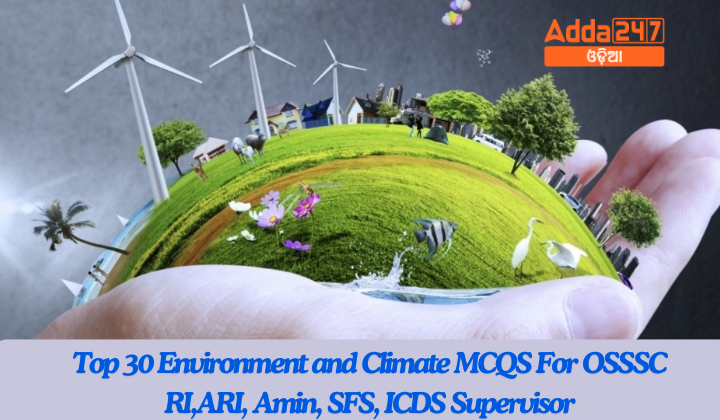Preparing for competitive exams like OSSSC RI, ARI, Amin, SFS, and ICDS Supervisor often requires a strong understanding of various subjects, including Environment and Climate. Here are 30 multiple-choice questions (MCQs) to help you prepare effectively.
Top 30 Environment and Climate MCQS For OSSSC RI,ARI, Amin, SFS, ICDS Supervisor
- What was the main cause of the recent deaths in Kerala from Primary Amoebic Meningoencephalitis (PAM)?
(a) Contaminated water
(b) Airborne particles
(c) Infected soil
(d) Unpasteurized milk
Ans. (a) Contaminated water - What type of safari was recently opened at Bannerghatta Biological Park?
(a) Leopard Safari
(b) Tiger Safari
(c) Elephant Safari
(d) Bear Safari
Ans. (a) Leopard Safari - Which organization updated the conservation status of the Iberian Lynx?
(a) International Union for Conservation of Nature (IUCN)
(b) World Wildlife Fund (WWF)
(c) Conservation International
(d) Wildlife Conservation Society (WCS)
Ans. (a) International Union for Conservation of Nature (IUCN) - What species is associated with the discovery of the world’s oldest termite mounds?
(a) Southern Harvester Termite (Microhodotermes viator)
(b) African Wood Termite (Macrotermes bellicosus)
(c) Asian Subterranean Termite (Coptotermes formosanus)
(d) Drywood Termite (Cryptotermes cynocephalus)
Ans. (a) Southern Harvester Termite (Microhodotermes viator) - Which new snake eel species was discovered in Odisha’s estuarine ecosystems?
(a) Ophichthus gomesii
(b) Myrichthys tigrinus
(c) Muraenesox cinereus
(d) Uropterygius vitta
Ans. (a) Ophichthus gomesii - Which new flower fly species is associated with Kerala’s biodiversity?
(a) Mesembrius quadrivittatus
(b) Mesembrius aethiopicus
(c) Mesembrius keraliensis
(d) Mesembrius westensis
Ans. (a) Mesembrius quadrivittatus - What is the main reason for the reclassification of the Ibiza wall lizard?
(a) Habitat destruction
(b) Climate change
(c) Invasive species
(d) Overhunting
Ans. (c) Invasive species - Which recent study has highlighted the impact of rising temperatures on ice sheets?
(a) West Antarctica Vulnerability Study
(b) Antarctic Ice Core Study
(c) Polar Ice Melt Report
(d) Arctic Temperature Trends Analysis
Ans. (a) West Antarctica Vulnerability Study - What was the focus of the recent research from the Zoological Survey of India (ZSI) in Odisha?
(a) New species of snake eel
(b) New bird species
(c) New mammal species
(d) New plant species
Ans. (a) New species of snake eel - Which recent conservation effort involved the Iberian Lynx?
(a) Status upgrade from Endangered to Vulnerable
(b) Reintroduction into the wild
(c) New habitat creation
(d) Anti-poaching measures
Ans. (a) Status upgrade from Endangered to Vulnerable - What notable feature did the discovered termite mounds in Namaqualand have?
(a) Oldest known mounds
(b) Largest size
(c) Most intricate structure
(d) Highest density
Ans. (a) Oldest known mounds - What is the primary impact of Wolbachia bacteria on the reproductive system of wasps?
(a) Male sterility
(b) Female-only offspring
(c) Increased reproductive rate
(d) Gender reversal
Ans. (b) Female-only offspring - Which recent discovery highlights the importance of biodiversity in the Andaman and Nicobar Islands?
(a) New plant species
(b) New mammal species
(c) New bird species
(d) New amphibian species
Ans. (a) New plant species - What significant event took place at the Bannerghatta Biological Park in June 2024?
(a) Opening of South India’s first leopard safari
(b) Launch of a new tiger conservation program
(c) Establishment of a new elephant sanctuary
(d) Inauguration of a bird watching center
Ans. (a) Opening of South India’s first leopard safari - Which study provided insights into the changing conservation status of the Iberian Lynx?
(a) IUCN Red List Update
(b) Wildlife Population Monitoring Report
(c) Conservation Status Review
(d) Species Survival Assessment
Ans. (a) IUCN Red List Update - What is the typical period for assessing climate?(a) 10 years
(b) 20 years
(c) 35 years
(d) 50 years
Ans: (c) 35 years
- What type of climate does most of India experience?(a) Polar
(b) Tropical
(c) Temperate
(d) Desert
Ans: (b) Tropical
- What climate characterizes the northern regions of India?(a) Dry tropical
(b) Wet tropical
(c) Humid tropical
(d) Temperate
Ans: (c) Humid tropical
- What defines weather?(a) Long-term patterns of variation
(b) Instantaneous state of the atmosphere
(c) Overall sum of weather conditions
(d) Climate over an extended duration
Ans: (b) Instantaneous state of the atmosphere
- What defines climate?(a) Instantaneous state of the atmosphere
(b) Long-term average patterns of variation
(c) Short-term weather conditions
(d) Weather on a specific day
Ans: (b) Long-term average patterns of variation
- Which part of India lies within the sub-tropical and temperate zones?(a) Northern section
(b) Southern section
(c) Western section
(d) Eastern section
Ans: (a) Northern section
- What is the maximum summer temperature recorded in Western Rajasthan?(a) 45°C
(b) 50°C
(c) 55°C
(d) 60°C
Ans: (c) 55°C
- What is the lowest winter temperature recorded around Drass?(a) -20°C
(b) -40°C
(c) -50°C
(d) -60°C
Ans: (d) -60°C
- Which region of India experiences minimal variation between day and night temperatures?(a) Western Rajasthan
(b) Andaman and Nicobar Islands
(c) Northern Himalayas
(d) Thar Desert
Ans: (b) Andaman and Nicobar Islands
- Which area in India receives annual precipitation surpassing 1150 cm?(a) Rajasthan
(b) Ladakh
(c) Meghalaya
(d) Western Ghats
Ans: (c) Meghalaya
- When does most of India receive rainfall?(a) January to March
(b) April to June
(c) June to September
(d) October to December
Ans: (c) June to September
- What factors protect India from the cold and dry winds of Central Asia?(a) Western Ghats
(b) Eastern Ghats
(c) Northern Mountain Ranges
(d) Deccan Plateau
Ans: (c) Northern Mountain Ranges
- Which ocean current significantly impacts weather conditions in India?(a) Gulf Stream
(b) El-Nino
(c) Kuroshio Current
(d) Benguela Current
Ans: (b) El-Nino
- What phenomenon causes a weakening of monsoon circulation in the Indian Ocean?(a) La-Nina
(b) El-Nino
(c) Southern Oscillation
(d) Tropical Cyclones
Ans: (b) El-Nino
- Which theory explains the monsoon as an extensive land breeze and sea breeze?(a) Dynamic Concept
(b) Jet Stream Theory
(c) Thermal Concept
(d) Indian Ocean Dipole
Ans: (c) Thermal Concept










